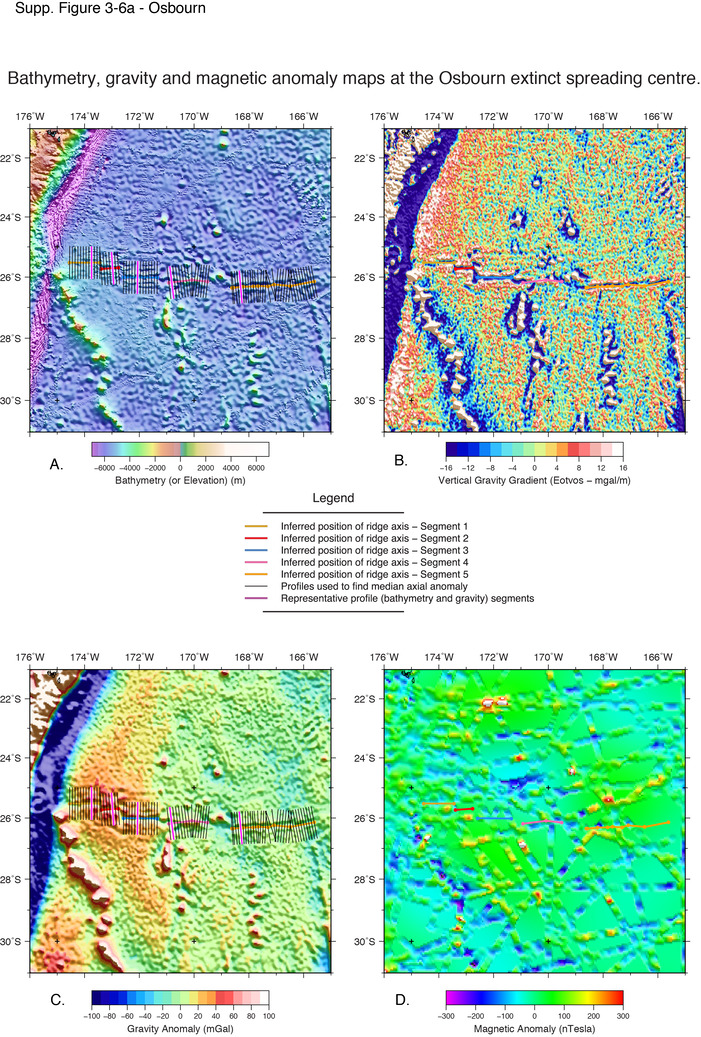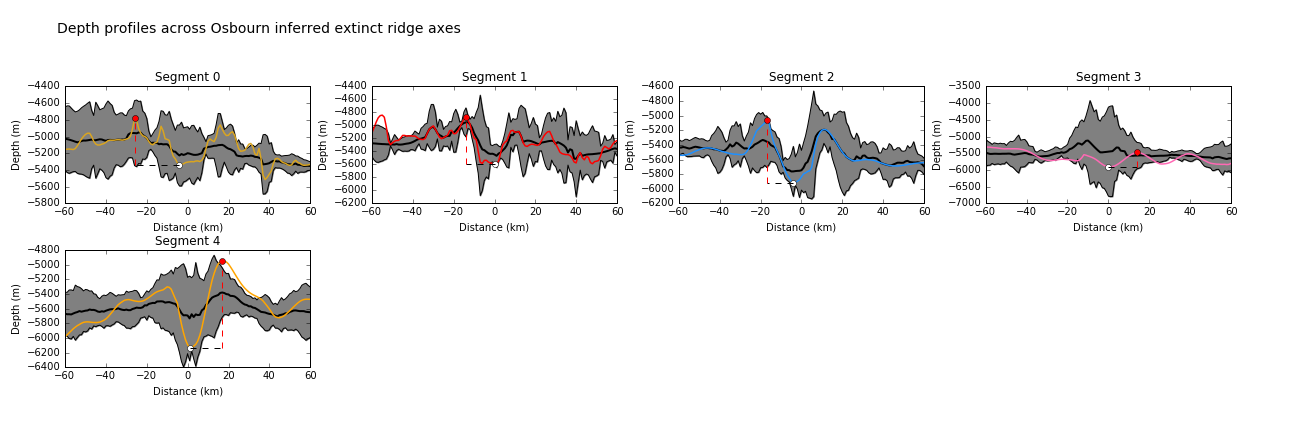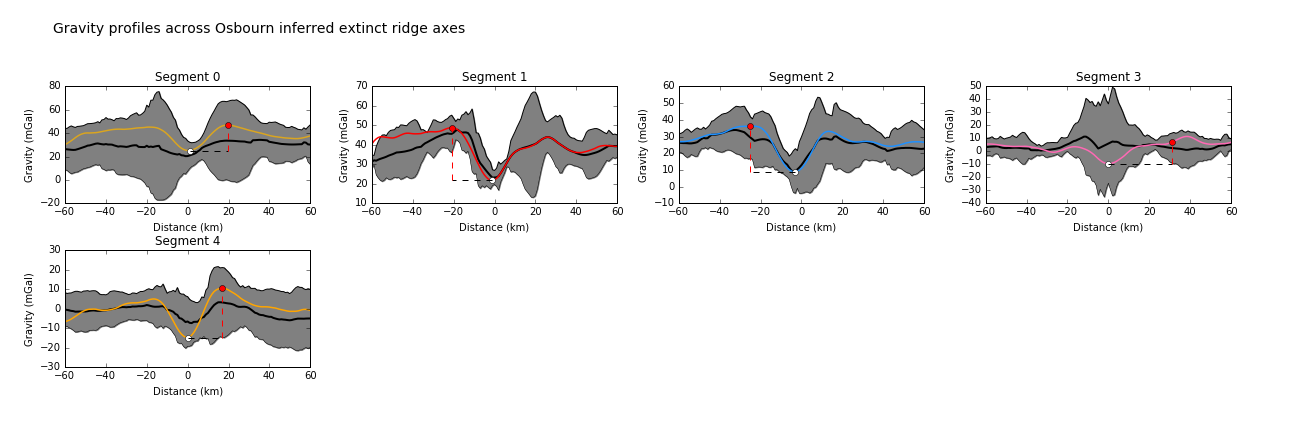The Osbourne Trough is a well-studied extinct ridge included in the primary tier of extinct ridges included in our study.
| Ocean: | Pacific |
| Spreading centre type: | Large-scale MOR or back-arc basin ridge |
| Time of cessation: | Ca. 86 Ma, during the Cretaceous Quiet Zone (Chandler et al., 2012) |
| Subsequent active spreading centre: | Tasman Sea to west |
| Cessation style: | Not constrained by available data |
| Later deformation or volcanism: | Segment 3 is reported to have two cross-cutting, fault bound troughs, with trend 110-120 parallel to Pacific plate motion (Worthington et al., 2006). Widespread “mass-wasting” (p.689) is also described. |
The Osbourn Trough is a distinctive bathymetric feature that has been well studied and firmly established as an extinct spreading centre. It is found to the east of the Tonga-Kermadec Trench, oriented approximately E-W, and was formed during the Cretaceous Normal Superchron, as the Phoenix-Pacific spreading system. It is thought that the spreading centre formed one limb of the triple junction of the Phoenix-Pacific-Farallon spreading system that also includes the Manihiki and Penrhyn possible extinct spreading centres, discussed within Supplementary Sections 3.10 and 3.8. The Tongareva spreading centre (ID 3.09) is also argued to have been the eastern continuation of this plate boundary (Phoenix-Pacific).
The westernmost segment that is in closest proximity to the trench is found to be the shallowest (Worthington et al., 2006), which may due to the current flexural response of the crust as it enters the Tonga trench to the west. The segments systematically deepen to the east and have an average flank elevatation around 600-800 m above the vallies, valley depths of around 5300-5700 m and several transform faults offset the respective segments by between 23 and 35 km (Worthington et al., 2006). Geochemical analysis of dredge samples from the axial valley scarps prove to be MORB like in general character, although minor variation is found in light REE concentrations (Worthington et al. 2006). The geochemistry suggest that the ridge basalts were not influenced by the Louiseville hotspot, which gives a higher Nb/Zr and normalized Ce/Yb ratio than was found for these samples (Worthington et al., 2006). A close similarilty is found with east-Pacific Rise basalt geochemistry. Lead isotope rations indicate Pacific mantle signature.
Worthington et al. (2006) argue that the Osbourne Trough became active around the time of eruption and emplacement of the Ontong Java and Manihiki Plateaus, which have both been constrained in age to 120 Ma by absolute dating. The authors propose that the Osbourne Trough was a western segment of Pacific-Phoenix migrating plate boundary, likely to have connected with the Penrhyn Basin to the east. The presence of adakites within neighbouring oceanic crust at the West Wishbone Ridge complicate this interpretation, however some explanations are provided by the authors (see Worthington et al., (2006) for further discussion).
Mortimer et al. (2006) obtained absolute ages for samples of oceanic crust to the south of the Osbourn Trough and directly west of the West Wishbone Scarp, which they date as 117 Ma, providing some constraints on the length of time the spreading centre was active. To the south, magnetic anomalies C34 and C33 have been reported, yet they young to the south, suggesting formation from a prior Pacific-Phoenix boundary, possibly one that became isolated after cessation of spread in the Ellice Basin. A recent study (Zhang and Li, 2016), reported a sample to the north of the Osbourn Trough was dated at 103.7 +/- 2.3 Ma, which is consistent with the proposed age of cessation.
At least one interpretation of the regional tectonic regime suggests an additional plate boundary (for example the Moa plate – see Sutherland and Hollis, 2001), at a similar orientation as the Osbourn Trough, suggesting multiple jumps of the triple junction to the south which has some similarity to theories of the Satsky Rise triple junction history (Sager et al., 1999).
The interaction of the Hikurangi plateau situated on the down-going Phoenix plate that was entering the Chatham Rise subduction zone, is thought to have and effectively blocked the plate-pull force that had been driving accretion at the Osbourn ridge (Worthington et al., 2006). Worthington et al. (2006) predict that cessation occurred at around 86 Ma.
Chandler, M. T., Wessel, P., Taylor, B., Seton, M., Kim, S.-S., Hyeong, K., 2012, Reconstructing Ontong Java Nui: Implications for Pacific absolute plate motion, hotspot drift and true polar wander, Earth and Planetary Science Letters, v. 331-332, p.140-151, doi: 10.1016/j.epsl.2012.03.017.
Downey, N. J., Stock, J. M., Clayton, R. W. and Cande, S. C., 2007, History of the Cretaceous Osbourn spreading center, Journal of Geophysical Research, v. 112, no. B04102, p. 1–18, doi:10.1029/2006JB004550.
Mortimer, N., Hoernle, K., Hauff, F., Palin, J. M., Dunlap, W. J., Werner, R. and Faure, K., 2006, New constraints on the age and evolution of the Wishbone Ridge, southwest Pacific Cretaceous microplates, and Zealandia - West Antarctica breakup, Geology, v. 34, no. 3, p. 185–188.
Sutherland, R. and Hollis, C., 2001, Cretaceous demise of the Moa plate and strike-slip motion at the Gondwana margin, Geology, v. 29, no. 3, p. 279–282.
Worthington, T.J., Hekinian, R., Stoffers, P., Kuhn, T., and Hauff, F., 2006, Osbourn Trough: Structure, geochemistry and implications of a mid-Cretaceous paleospreading ridge in the South Pacific, Earth and Planetary Science Letters, v. 245, no. 3-4, p. 685–701.
Zhang, G.-L., and Li, C., 2016, Interactions of the Greater Ontong Java mantle plume with the Osbourn Trough, Nature, doi: 10.1038/srep37561.


